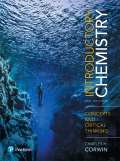
Concept explainers
(a)
Interpretation:
The change in the pressure if the volume of a gas is increased is to be stated.
Concept introduction:
Boyle’s law which relates pressure and temperature states that when temperature is kept constant for a gas then the pressure and temperature follows an inverse relation. According to Boyle’s law relation between pressure and volume is written below.
Answer to Problem 9E
With increase in the volume, the net value of pressure decreases.
Explanation of Solution
Boyle’s law for the gaseous molecule is stated below.
Where,
•
•
•
According to the equation of Boyle’s law if volume is increased for a particular or constant temperature then the pressure of the gas will be decreased to maintain the
Therefore, pressure decreases with increase in volume.
Pressure decreases with increase in volume of a gas.
(b)
Interpretation:
The change in pressure when the temperature of a gas is increased is to be stated.
Concept introduction:
Gay Lussac’s law relates the pressure and temperature for a particular gas when rest of the variables is constant. Gay Lussac’s law or given relation between pressure and temperature is written below.
Answer to Problem 9E
If the temperature
Explanation of Solution
Relation given by Gay Lussac’s for the gaseous molecule is stated below.
Where,
•
•
•
Ratio of pressure and temperature is constant. Pressure will be increased with the increase in value of temperature to maintain the
Therefore, pressure increases with increase in temperature.
With increased temperature of a gas, the pressure of the gas also increases.
(c)
Interpretation:
The change in the pressure when moles of a gas are increased is to be stated.
Concept introduction:
Answer to Problem 9E
The pressure of a gas increases with increase in number of moles of a gas.
Explanation of Solution
Relation given by all the variables of a gas is stated below.
Where,
•
•
•
•
Combined gas law is written below.
Where,
•
According to the relation given above pressure is directly proportional to the number of moles. Pressure will be increased with the increase in value of number of moles to maintain the gas law.
Therefore, pressure increases with increase in number of moles of a gas.
The increase in the number of moles
Want to see more full solutions like this?
Chapter 10 Solutions
EBK INTRODUCTORY CHEMISTRY
- What is the value of the ideal gas constant R if the volume is specified in milliliters rather than liters?arrow_forwardLiquid oxygen was first prepared by heating potassium chlorate, KClO3, in a closed vessel to obtain oxygen at high pressure. The oxygen was cooled until it liquefied. 2KClO3(s)2KCl(s)+3O2(g) If 171 g of potassium chlorate reacts in a 2.70-L vessel, which was initially evacuated, what pressure of oxygen will be attained when the temperature is finally cooled to 25C? Use the preceding chemical equation and ignore the volume of solid product.arrow_forward
 General Chemistry - Standalone book (MindTap Cour...ChemistryISBN:9781305580343Author:Steven D. Gammon, Ebbing, Darrell Ebbing, Steven D., Darrell; Gammon, Darrell Ebbing; Steven D. Gammon, Darrell D.; Gammon, Ebbing; Steven D. Gammon; DarrellPublisher:Cengage Learning
General Chemistry - Standalone book (MindTap Cour...ChemistryISBN:9781305580343Author:Steven D. Gammon, Ebbing, Darrell Ebbing, Steven D., Darrell; Gammon, Darrell Ebbing; Steven D. Gammon, Darrell D.; Gammon, Ebbing; Steven D. Gammon; DarrellPublisher:Cengage Learning World of Chemistry, 3rd editionChemistryISBN:9781133109655Author:Steven S. Zumdahl, Susan L. Zumdahl, Donald J. DeCostePublisher:Brooks / Cole / Cengage Learning
World of Chemistry, 3rd editionChemistryISBN:9781133109655Author:Steven S. Zumdahl, Susan L. Zumdahl, Donald J. DeCostePublisher:Brooks / Cole / Cengage Learning Introductory Chemistry: A FoundationChemistryISBN:9781337399425Author:Steven S. Zumdahl, Donald J. DeCostePublisher:Cengage Learning
Introductory Chemistry: A FoundationChemistryISBN:9781337399425Author:Steven S. Zumdahl, Donald J. DeCostePublisher:Cengage Learning- Chemistry: Matter and ChangeChemistryISBN:9780078746376Author:Dinah Zike, Laurel Dingrando, Nicholas Hainen, Cheryl WistromPublisher:Glencoe/McGraw-Hill School Pub Co
 General, Organic, and Biological ChemistryChemistryISBN:9781285853918Author:H. Stephen StokerPublisher:Cengage Learning
General, Organic, and Biological ChemistryChemistryISBN:9781285853918Author:H. Stephen StokerPublisher:Cengage Learning Introductory Chemistry: An Active Learning Approa...ChemistryISBN:9781305079250Author:Mark S. Cracolice, Ed PetersPublisher:Cengage Learning
Introductory Chemistry: An Active Learning Approa...ChemistryISBN:9781305079250Author:Mark S. Cracolice, Ed PetersPublisher:Cengage Learning





